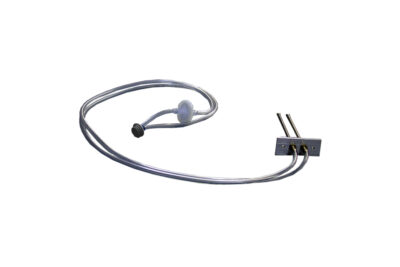Duct Sampling Kit

A special probe assembly that attaches to a gas detector and is mounted on the return air duct of a ventilation system to measure the concentration levels of a target gas passing through the duct
Allows for the continuous monitoring of the quality of the air being circulated around the building
Applications
- Office Buildings
- Airports
- Hotels
- Hospitals
- Shopping Malls
- and many more…
Key Features
- Continuous hazardous gas monitoring for indoor air ventilation systems
- Ideal for monitoring carbon monoxide, carbon dioxide and other lighter than air gases
- Easy to install
- Comes with a dust fillter to keep sensor free of dust and particles
Description
The Duct Sampling Kit is designed to enable the gas detector to measure the concentration levels of a target gas in indoor duct ventilation systems. The plug fits securely into the sensor vent on the front of the gas detector / transmitter. Once the sample air passes over the sensor, it returns back to the air duct through the opposite tube (downstream return port). It allows for the continuous monitoring of the quality of the air being circulated around the building.
The kit includes a dust filter, a plug, two 1.23 m / 4 ft lengths of tubing and a probe assembly. The probe assembly should be mounted on the return air duct at a point where there is unrestricted airflow, no internal duct components that will interfere with the device, and away from fresh air intakes that might pull in other gases or emissions from outside (unless the application is the detection of gases or emissions from outside).
The dust filter should be on the tubing with the probe that intakes the air towards the gas detector (upstream sample port), so any particles blowing through the ventilation system will be trapped and not contaminate the sensor. The dust filter should be replaced when it gets dirty; the replacement period will differ by location and application. A simple visual inspection will help determine when it needs to be replaced. The more dust and dirt that builds up, the darker in colour the filter will become.
The difference between the total pressure at the upstream sample port and the static pressure at the downstream return port propels the sample stream of air over the sensor allowing for the detection of the target gas if present. For an adequate gas reading, a minimum of 200 cfm air movement within the duct is required.
NOTE: The Duct Sampling Kit is not recommended for monitoring “sticky gases” such as ozone, chlorine, nitrogen dioxide, hydrogen chloride or ammonia. Sticky gases adhere to surfaces, and will adhere to the tubing and result in an incorrect concentration readings. It is also not recommended for monitoring refrigerant gases.

